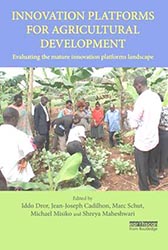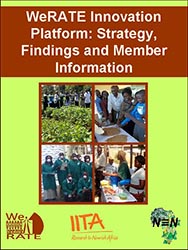The country team in Kenya has produced three recent publications that may interest N2Africa partners in other countries. These publications include an article within an open access scientific journal, a book chapter on our Innovation Platform and a widely-distributed 48-page extension booklet covering our outreach operations.
Characterization of Small-scale farming systems in West Kenya and Opportunities for their Improvement. This paper is based upon results obtained during the N2Africa Phase I Early Impact Assessment and other project M&E findings. It recognizes that designing agricultural transformation strategies that modernize small-scale farming in Africa require actions built upon solid, holistic baselines and proven, affordable technical intervention. Information was collected among 291 farm households in western Kenya that participated in the dissemination of BNF technologies and improved soyabean and climbing bean varieties prior to survey. It contrasts farming practices among small-scale farmers across different agro-ecological zones and resource endowments, and between female- and male-headed households. This situation analysis leads to a consideration of what sort of farming systems studies are likely to assist in fuller understanding of entry point interventions, including BNF and legume technologies. It appears in the open-access Universal Journal of Agricultural Research, 4(4), pp.109-120.
| Humidtropics Innovative Platform Case Study: WeRATE Operations in West Kenya. This book chapter results from a call by the Humidtropics Program for recent information about "mature" Innovation Platforms. The Western Regional Agricultural Technology Evaluation (WeRATE) is a platform for testing pilot agricultural technologies and new input products within the N2Africa Project and Humidtropics Program. It is an open-membership umbrella organization, with 24 dues-paying members; mostly local NGOs, farmer associations, input suppliers, and commodity distributors and buyers. In this way, WeRATE does not work directly with individual farmers, rather through their organizations and is able to reach over 79,000 households. WeRATE prefers to work with commercially available inputs so that the results of its technology tests can be quickly scaled up among its membership. The case study documents WeRATE’s approaches, operations and achievements, and its example and experiences are useful to others seeking to establish effective Innovation Platforms. It appears as chapter 6 in Innovation Platforms for Agricultural Development: Evaluating the mature innovation platforms landscape (I. Dror et al., eds.) Earthscan-Routledge, Oxford, UK, pp. 98-116. |  |
| WeRATE Innovation Platform: Strategy, Findings and Member Information. This booklet provides a detailed description of the WeRATE Platform. It results in large part from grassroots demand that more information be provided about individual WeRATE members, rather than the umbrella organization as a whole, in reporting important project developments. WeRATE is a leading mechanism for farmer training and the evaluation, promotion and dissemination of agricultural technologies in Kenya. It currently works through three projects; N2Africa Project, the Humidtropics Program and the IFAD Root Crops Project. WeRATE is an open-membership umbrella organization that hosts the semi-annual Agricultural Technology Clearinghouse and works at the grassroots level through its Master Farmer Network. This booklet introduces the Innovation Platform as a whole, its individual subscribing members and the results of its on-farm technology tests during 2015. It is published by IITA-Kenya and WeRATE Platform, printed by Digital Hub, Nairobi, and may be reproduced for non-commercial application provided that its authors and organizations are acknowledged. |  |
Paul Woomer and Welissa Mulei
